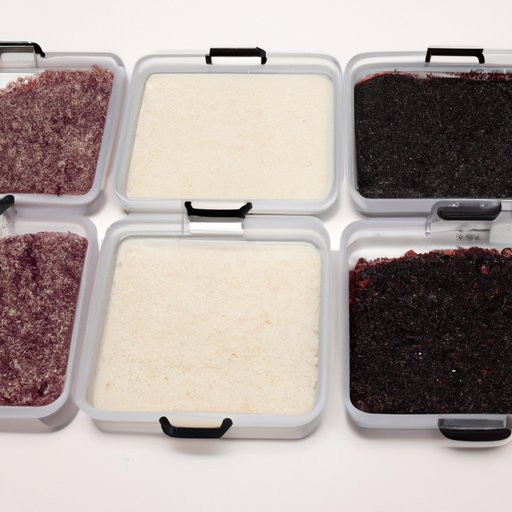
How to Store Rice: Creative Ideas and Best Practices
Rice is a staple food that is loved by many. It is consumed by millions of people around the world and is an essential ingredient in many dishes. Proper storage of rice is essential to maintain its flavor and extend its life. Rice that is stored incorrectly may become contaminated with bacteria or insects, which can render it useless. This article provides various storage ideas and best practices to keep your rice fresh and healthy for a longer period of time.
5 Creative Ideas for Storing Rice Efficiently
There are a variety of ways to store rice creatively and efficiently. Here are some of the most effective methods:
Use of a vacuum-sealed container
Vacuum-sealed containers are a great way to store rice as they eliminate air, which is one of the primary causes of spoiling food. A vacuum-sealed container will help to keep the rice fresh and prevent moisture and insects from affecting the rice. You can purchase vacuum-sealed containers from most home goods stores or online.
Incorporating silicone packets to prevent moisture buildup
Silicone packets are used to absorb excess moisture in containers. These packets contain tiny beads of silica gel that can absorb moisture before it affects the rice. You can save these packets from other products, or order them online or from a packaging or craft store. Inserting a few silicone packets into your rice container will help keep it moisture-free.
Using airtight jars to keep insects away
Insects such as moths and weevils thrive in warm, damp environments, making rice a prime target. To prevent the invasion of insects, consider storing your rice in airtight glass or plastic jars. These jars should be stored in dark, cool places such as pantries or cabinets.
Other unique storage solutions
Other creative solutions for storing rice include using airtight plastic bags or containers if your primary containers are too large. If you have a bountiful supply of rice, divide it into smaller sections to store in various places. A rice drawer is another innovative alternative to the traditional pantry or cupboard.
The Dos and Don’ts of Storing Rice
Familiarizing yourself with the basic “dos and don’ts” of storing rice will help to ensure that your rice maintains its quality. Here are some helpful tips:
Avoid using old containers
Storing your rice in old or worn-out containers can expose it to the elements and cause contamination. Always store rice in clean, airtight containers.
Keep rice in a dry, cool place to prevent spoilage
Rice can react with moisture in the environment and become contaminated. Store your rice in a cool, dry place to keep it fresh and prevent spoilage from occurring. Avoid placing rice in direct sunlight or near heat sources like stovetops.
Other best practices to follow
Prime storage areas for rice include pantries, cupboards, and other dark and cool places. Regardless of the storage method used, rice should be kept away from open air. You should not store rice in the freezer or refrigerator as the moisture inside can turn into ice and damage its texture and taste.
Things to avoid when storing rice
Avoid storing rice near strong-smelling or off-putting items such as spices, herbs, or chemicals. To avoid unwanted odors affecting your rice, keep different storage containers for different food items.
How to Store Different Types of Rice
It is essential to consider the type of rice you are storing as different grains require unique storage methods. Below are some examples of rice types:
Short-grain rice:
This type of rice is high in starch and is commonly used in sushi and risotto dishes. Short-grain rice has a soft, fluffy texture, making it susceptible to moisture damage. Therefore, it is best stored in a vacuum-sealed container to eliminate moisture buildup and extend its shelf life.
Long-grain rice:
Long-grain rice is the most common type and is consumed in most households. It is best stored in an airtight container similar to short-grained rice but doesn’t require the use of a vacuum-sealed container.
Basmati rice:
Basmati rice is popular in Middle Eastern and Asian cuisines. It is known for its nutty, fragrant flavor profile. For optimal storage, basmati rice should be kept in an airtight container in a cool, dry place. It should be used within six months of purchase.
Arborio rice:
This short-grain Italian rice is typically used in dishes like risotto and rice pudding. Like short-grained rice, Arborio should be stored in a vacuum-sealed container to maintain its original texture and flavor.
The Benefits of Properly Storing Rice
Storing rice correctly has numerous benefits, such as preventing mold growth and insect infestation. Below are some of the reasons why proper storage of rice is essential:
Storing Rice for Emergency Preparedness
Rice is a crucial item for an emergency preparedness kit as it is an inexpensive food source that can last for several years. Keeping rice stored in an airtight container or vacuum-sealed bag is essential to extend its shelf life.
It is recommended that you rotate the rice in your stockpile to ensure that the rice stays fresh. Additionally, consider purchasing quick-cooking rice which requires less water and cooking time, making it easier to prepare in an emergency.
Conclusion
Proper storage of rice is essential to prevent it from spoiling or becoming contaminated. Storing rice in a cool, dry place and in airtight containers are effective methods to keep it fresh and healthy. By following the tips provided in this article, you can prevent mold, insect infestations, and other problems for extended periods of time.
Always remember that proper storage of rice is essential for optimum taste, safety, and nutritional value. So next time you buy your favorite grain, store it wisely and taste your recipe exactly like you want.




